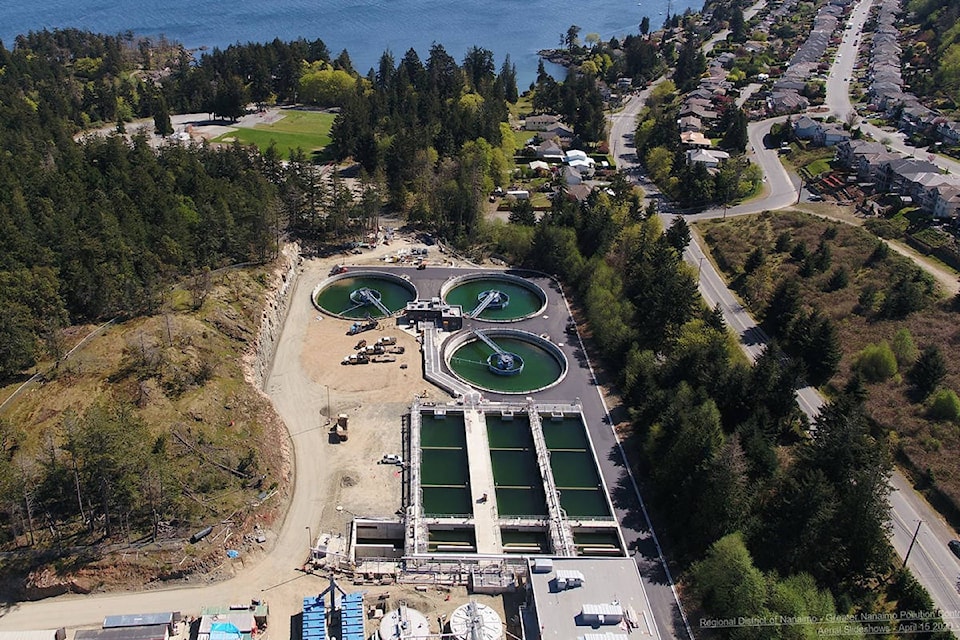An $82-million upgrade at the Greater Nanaimo Pollution Control Centre is greatly improving quality of water being discharged, says Regional District of Nanaimo staff.
The RDN announced in April that the secondary wastewater treatment project at the north Nanaimo facility was complete, utilizing technology that extracts solids during treatment. In a RDN liquid waste management plan monitoring committee presentation Thursday, Ryan Powell, RDN wastewater services’ senior lab technician, said effluent being discharged is less harmful to the environment.
Powell said carbonaceous biochemical oxygen demand is a measure of the oxygen demand of a sample. A sample with high oxygen demand can lead to depletion of oxygen in water, he said. Current provincial regulations are 130 milligrams/litre daily and federally, 140mg/L for monthly average, however, new regulations take effect in the next year for 45mg/L daily provincially and a 25mg/L monthly average federally.
“Commissioning began in September 2020 and there was a huge decrease in our CBOD,” Powell told the committee. “A month prior to commissioning beginning, our CBOD was 100mg/L. The month the commissioning began … that dropped to 68 and then in October, it dropped to 4.6. Incredible reduction.”
Powell also referenced total suspended solids found in water, a measure of particles which are unable to be filtered through a 1.5-micron filter. High levels of total suspended solids can be detrimental to the park ecosystem and clog fish scales and affect fish eggs.
“Prior to secondary [treatment], we saw 68mg/L, that dropped to 46 in the first month and then dropped all the way down to eight in the second month … we see the same nice drastic decrease that we’re seeing with [CBOD] and that decrease has been very stable since the commissioning occurred,” said Powell.
Ammonia levels are also tracked. Powell said un-ionized ammonia are the most detrimental form of nitrogen to fish and aquatic ecosystems. Samples are sent for testing using rainbow trout and various concentration samples for 96 hours. If more than 50 per cent of trout die, in samples with 100 per cent concentration, the effluent is considered “acutely lethal.” Before secondary treatment, there was an average of 41mg/L, Powell said.
“The secondary treatment plant is able to remove ammonia using [a nutrient removal process],” he said. “In 2021, we’ve seen really great ammonia removal ranging from 37 per cent in the winter months. You can’t get as much [removal] in the winter months because the temperature is lower, so the bacteria are less active … by the end of April, we were seeing numbers closer to 60-61 per cent and even higher in the last week.”
Last month, the average was 19.7mg/L, he said, and two toxicity tests saw all the fish surviving testing at 100 per cent concentration.
Don Bonner, RDN director and committee chairperson, told the News Bulletin he was pleased with the secondary treatment results and while it isn’t being considered yet, tertiary treatment would be the next step.
“Right now the water is well [within] the provincial standards, however, tertiary treatment frees us up for a lot more options in terms of recycling and reusing the water, that would be our next step going forward,” said Bonner. “It’s fairly expensive. To get the last 10 per cent [effluent in water] out is quite expensive.”
RELATED: Nanaimo’s $82M pollution control upgrade complete
RELATED: RDN finalizes financing for next phase of $80M pollution control upgrade
reporter@nanaimobulletin.com
Like us on Facebook and follow Karl on Twitter and Instagram
